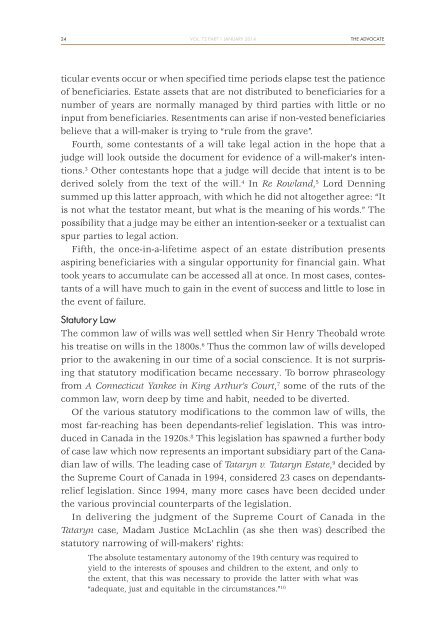Advocate Jan 2014
Advocate Jan 2014
Advocate Jan 2014
You also want an ePaper? Increase the reach of your titles
YUMPU automatically turns print PDFs into web optimized ePapers that Google loves.
24 VOL. 72 PART 1 JANUARY <strong>2014</strong><br />
THE ADVOCATE<br />
ticular events occur or when specified time periods elapse test the patience<br />
of beneficiaries. Estate assets that are not distributed to beneficiaries for a<br />
number of years are normally managed by third parties with little or no<br />
input from beneficiaries. Resentments can arise if non-vested beneficiaries<br />
believe that a will-maker is trying to “rule from the grave”.<br />
Fourth, some contestants of a will take legal action in the hope that a<br />
judge will look outside the document for evidence of a will-maker’s intentions.<br />
3 Other contestants hope that a judge will decide that intent is to be<br />
derived solely from the text of the will. 4 In Re Rowland, 5 Lord Denning<br />
summed up this latter approach, with which he did not altogether agree: “It<br />
is not what the testator meant, but what is the meaning of his words.” The<br />
possibility that a judge may be either an intention-seeker or a textualist can<br />
spur parties to legal action.<br />
Fifth, the once-in-a-lifetime aspect of an estate distribution presents<br />
aspiring beneficiaries with a singular opportunity for financial gain. What<br />
took years to accumulate can be accessed all at once. In most cases, contestants<br />
of a will have much to gain in the event of success and little to lose in<br />
the event of failure.<br />
Statutory Law<br />
The common law of wills was well settled when Sir Henry Theobald wrote<br />
his treatise on wills in the 1800s. 6 Thus the common law of wills developed<br />
prior to the awakening in our time of a social conscience. It is not surprising<br />
that statutory modification became necessary. To borrow phraseology<br />
from A Connecticut Yankee in King Arthur’s Court, 7 some of the ruts of the<br />
common law, worn deep by time and habit, needed to be diverted.<br />
Of the various statutory modifications to the common law of wills, the<br />
most far-reaching has been dependants-relief legislation. This was introduced<br />
in Canada in the 1920s. 8 This legislation has spawned a further body<br />
of case law which now represents an important subsidiary part of the Canadian<br />
law of wills. The leading case of Tataryn v. Tataryn Estate, 9 decided by<br />
the Supreme Court of Canada in 1994, considered 23 cases on dependantsrelief<br />
legislation. Since 1994, many more cases have been decided under<br />
the various provincial counterparts of the legislation.<br />
In delivering the judgment of the Supreme Court of Canada in the<br />
Tataryn case, Madam Justice McLachlin (as she then was) described the<br />
statutory narrowing of will-makers’ rights:<br />
The absolute testamentary autonomy of the 19th century was required to<br />
yield to the interests of spouses and children to the extent, and only to<br />
the extent, that this was necessary to provide the latter with what was<br />
“adequate, just and equitable in the circumstances.” 10


